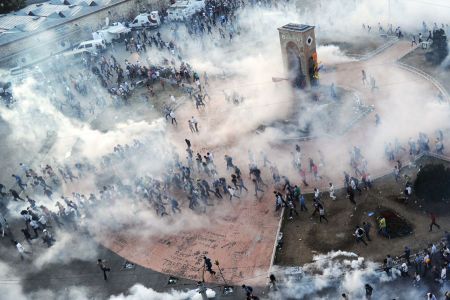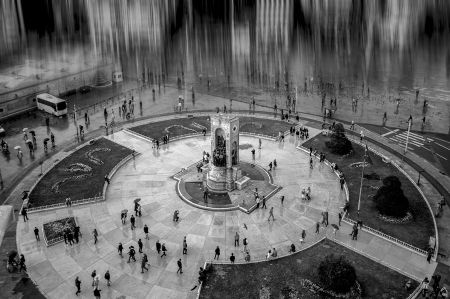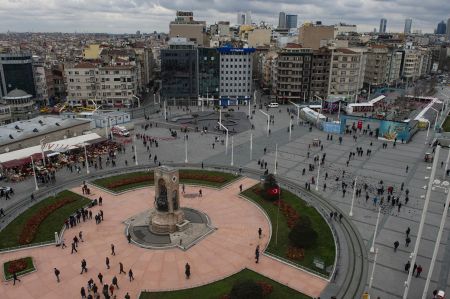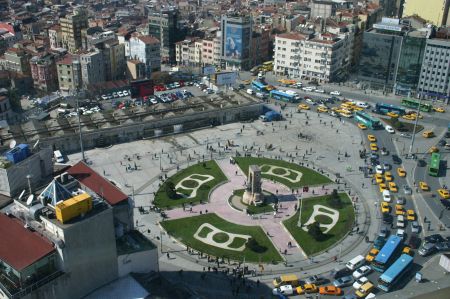History of the media-heavy Taksim Square in Istanbul
- Written by Portal Editor
A little bit of history about Taksim Square in Istanbul, which has once again attracted a great deal of attention from the media. Taksim Square in Istanbul has always been considered the city's most important transport hub.
In the middle of the square stands the "Monument to the Republic" (Turkish: Cumhuriyet Anıtı), erected in 1928, to commemorate the founding of the Republic of Turkey in 1923. Important thoroughfares led from this central location in all directions, including Tarlabaşı Bulvarı in the direction of Fatih, Cumhuriet Caddesi to the northern district of Şişli, Inönü Caddesi in the direction of Beşiktaş and Istiklal Caddesi down to Tünel Square, with the exception of this street today the tourist tram and a little delivery traffic became a pedestrian zone. The historic tram "Nostaljik Tramvay" has a turning loop on Taksim Square, which runs around the "Monument of the Republic". Istiklal Caddesi is better known under the earlier term Grande rue de Pera. But Taksim was often also the place of rallies and events.
Taksim Square always protest actions
 Right now, in addition to Gezi Park, everyone is talking about Taksim Square in Istanbul as a place of civil protest, especially since the Turkish police carried out multiple violent evictions against mostly peaceful demonstrators at the end of May and June of this year. And the protests continue. The center of the square is the Monument to the Republic, which is considered the central wreath-laying spot in Istanbul for state holidays. In the past few decades, there have been repeated protest actions by Turkish trade unions, often left-wing parties or youth movements on Taksim Square.
Right now, in addition to Gezi Park, everyone is talking about Taksim Square in Istanbul as a place of civil protest, especially since the Turkish police carried out multiple violent evictions against mostly peaceful demonstrators at the end of May and June of this year. And the protests continue. The center of the square is the Monument to the Republic, which is considered the central wreath-laying spot in Istanbul for state holidays. In the past few decades, there have been repeated protest actions by Turkish trade unions, often left-wing parties or youth movements on Taksim Square.
For example, February 16, 1969, which went down in Turkish history as Bloody Sunday, was one such day of protest when students, supported by the unions and left-wing opposition groups. The peaceful demonstration turned into "Bloody Sunday" when police allowed about 500 aggressive attackers into Taksim Square, where they attacked the protesters with knives, chains and clubs. Two people were killed and more than a hundred people injured under the eyes of the police.
Taksim massacre in 1977
 Just 8 years later came the so-called Taksim Massacre in 1977, when participants at a May Day trade union rally were shot at by unknown gunmen. The assassins positioned themselves on the roofs of the Intercontinental Hotel, today's Marmara Istanbul Hotel, and in the water authority building and opened fire on the demonstrators. Combined with police armored vehicles, noise bombs and automatic weapon fire, Taksim Square turned into a battlefield where 34 people died and hundreds were injured. 453 demonstrators alone were arrested. The assassins are still not known, and the massacre as a whole has not been explained. For the next three decades, Taksim Square was then closed for May Day rallies and May Day was henceforth considered an unofficial holiday. After the military coup of September 12, 1980, May Day celebrations were banned throughout Turkey. These celebrations have only been held again since 1988.
Just 8 years later came the so-called Taksim Massacre in 1977, when participants at a May Day trade union rally were shot at by unknown gunmen. The assassins positioned themselves on the roofs of the Intercontinental Hotel, today's Marmara Istanbul Hotel, and in the water authority building and opened fire on the demonstrators. Combined with police armored vehicles, noise bombs and automatic weapon fire, Taksim Square turned into a battlefield where 34 people died and hundreds were injured. 453 demonstrators alone were arrested. The assassins are still not known, and the massacre as a whole has not been explained. For the next three decades, Taksim Square was then closed for May Day rallies and May Day was henceforth considered an unofficial holiday. After the military coup of September 12, 1980, May Day celebrations were banned throughout Turkey. These celebrations have only been held again since 1988.
When a suicide attack took place during a demonstration on October 31, 2010 in Taksim Square, 32 people were injured. At the end of 2012, Taksim Square was completely closed to traffic due to construction work. In April 2013 there were the first massive protests on Taksim Square against the demolition of the Emek Cinema and the resulting arbitrary policy of urban renewal, which apparently wants to remove all monuments of Kemalism and the westernization that went with it, because at least the Emek Cinema was considered to be Candidate for UNESCO World Heritage. As part of the May Day celebrations on May 1, 2013, demonstrators tried to advance as far as Taksim Square, which the police were supposed to prevent. During the clashes with the police, 16 people were injured.
On May 27, 2013, demonstrations began in Taksim Square against plans for urban renewal and against the felling of trees in Gezi Park. In the early morning of May 31, 2013, Turkish police cordoned off the square; they set fire to tents where demonstrators were camping or sleeping and attacked them with tear gas and pepper spray. In the days that followed, these demonstrations spread to other cities; Many people express dissatisfaction with the authoritarian policies of Prime Minister Recep Tayyip Erdoğan, who has been in power for the past ten years and who is also chairman of the governing Adalet ve Kalkınma Partisi (AKP) party.
Taksim is derived from Arabic
 If we go further back in the history of Taksim Square, we also come across the origin of its name and the former function of this highest point in Istanbul's Beyoğlu district. The name Taksim derives from the Arabic meaning of partition or division, not, as one might now assume, in the distribution of roads but in the distribution of water. The 23-kilometer-long water pipeline built in 1731 to supply the city with fresh water ended here at Taksim. By order of Sultan Mahmud I, a distribution system was built here in 1732, connected to the water supply from the north in the so-called Belgrade Forest. This distribution station ensured the distribution of drinking water into the districts of Kasımpaşa, Galata, Beyoğlu, Fındıklı and Beşiktaş, which was continuously expanded up to the 19th century.
If we go further back in the history of Taksim Square, we also come across the origin of its name and the former function of this highest point in Istanbul's Beyoğlu district. The name Taksim derives from the Arabic meaning of partition or division, not, as one might now assume, in the distribution of roads but in the distribution of water. The 23-kilometer-long water pipeline built in 1731 to supply the city with fresh water ended here at Taksim. By order of Sultan Mahmud I, a distribution system was built here in 1732, connected to the water supply from the north in the so-called Belgrade Forest. This distribution station ensured the distribution of drinking water into the districts of Kasımpaşa, Galata, Beyoğlu, Fındıklı and Beşiktaş, which was continuously expanded up to the 19th century.
Until the end of the 19th century, private houses were hardly connected to the public water network, the population living in Istanbul mainly used public wells for their own supply. Of the 10,000 houses in the Beyoğlu district at that time, only 80 were connected to the pipeline system. The situation of the palaces on Taksim Square is of course completely different. Around 1900, the Yıldız Palace alone consumed about 1/3 of the entire available drinking water from its own water supply from the distribution system at Taksim Square.
With the installation of modern waterworks in the 1880s, the houses on Taksim were also connected to the public supply network, which meant that the Taksim water distribution station lost its importance for the city and the Beyoğlu district. Around the year 1950, the entire pipeline system to Taksim Square and the distribution station were shut down. From the former water distribution station, the flat building used as a water reservoir on the western edge of Taksim Square is preserved today, as well as an octagonal building at the southern end of Taksim, which was once the actual distribution station. Even today, however, the reservoirs in the so-called Belgrade Forest are important bastions of Istanbul's water supply.
Right to have a say in urban development projects effectively abolished
It is not without reason that the current protest actions are also directed against the planned city expansions, the construction of an even more spectacular airport and the third Bosporus Bridge project and the Black Sea-Marmara Sea Canal, which mean further deep interventions in nature and thus in the water balance of the stand supply. Punishing the Turkish Chamber of Architects, which played a key role in the protest actions, with the exclusion from public planning procedures by the AKP-led parliament is certainly not a way of solving the problems.
The Turkish Union of Architects and Engineers (TMMOB) fumed on Thursday at a law passed during the week that effectively abolished its previous say in urban development projects. The law, drafted by Erdogan's conservative Islamic AKP party, is intended to weaken the union, brand it as an illegal organization and "can undoubtedly be seen in connection with the Gezi Park movement," TMMOB leader Mehmet Soganci told the AFP news agency.
Please read as well:
Istanbul: Will the idea of Pliny Canal become reality after all?
